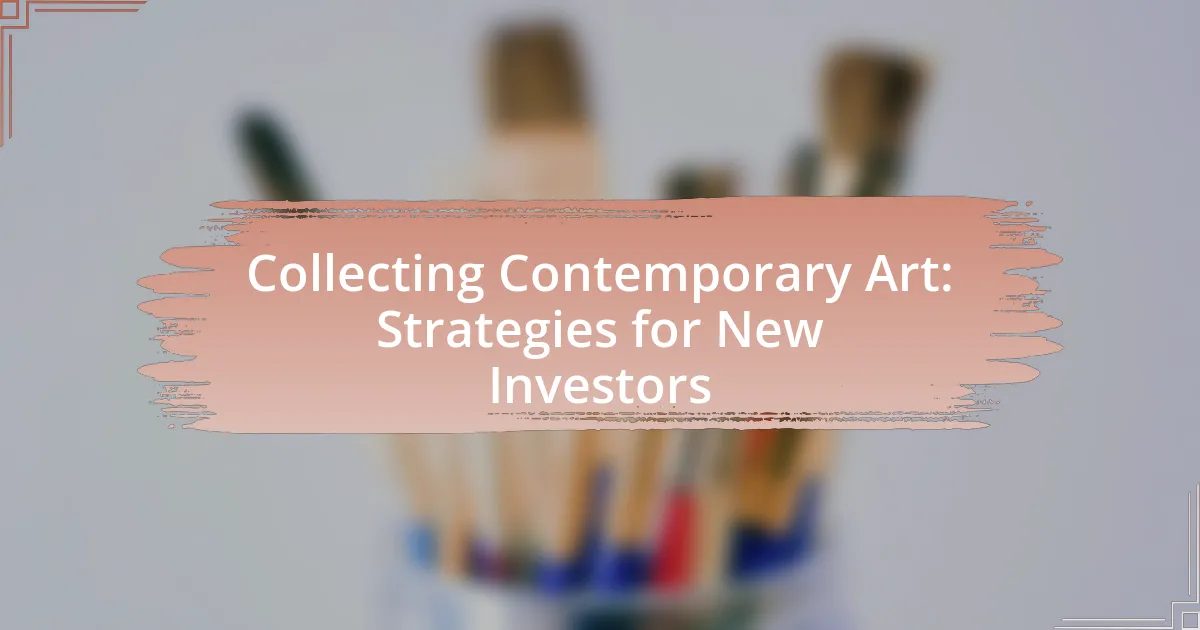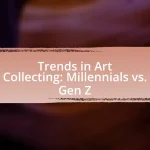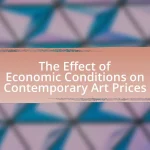Collecting contemporary art involves acquiring works from living artists or those active in recent decades, reflecting current cultural dialogues and supporting emerging talent. The contemporary art market has experienced significant growth, with global sales reaching approximately $2.7 billion in 2021, driven by a younger demographic of collectors. This article outlines the significance of contemporary art, the evolution of its perception, and the motivations for investing in it. It also provides strategies for new investors, including research, networking, and identifying valuable artists, while highlighting the importance of art fairs and online platforms in the collecting process. Additionally, it addresses common pitfalls and offers practical tips for successful investment in contemporary art.
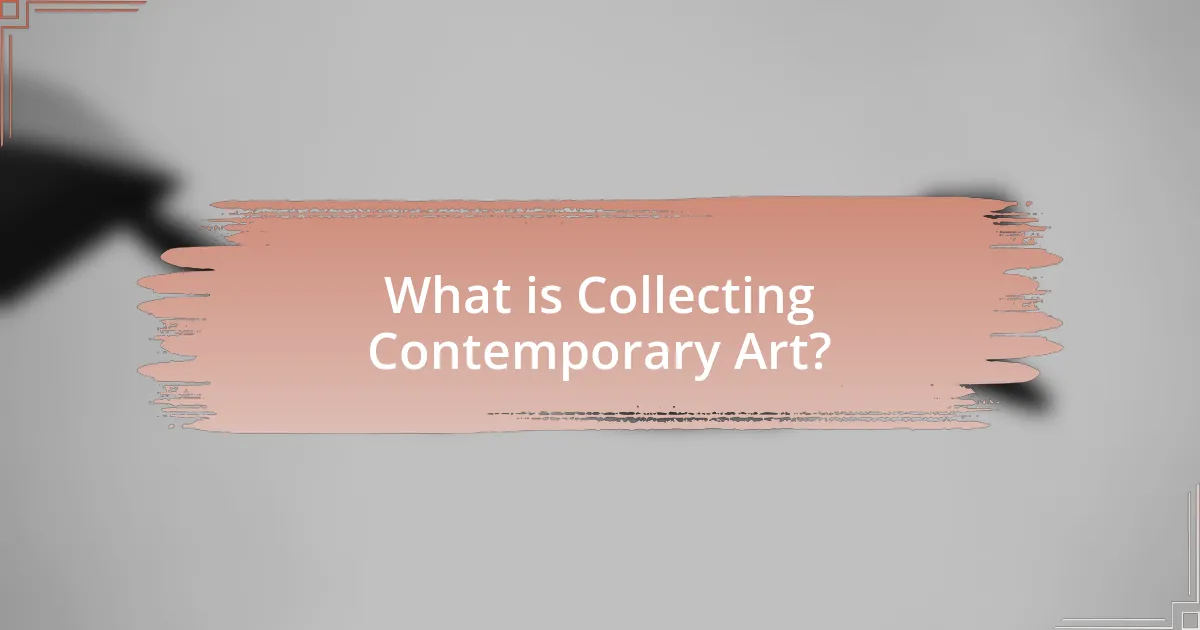
What is Collecting Contemporary Art?
Collecting contemporary art involves acquiring artworks created by living artists or those who have produced work within the last few decades. This practice allows collectors to engage with current cultural dialogues and support emerging talent. The contemporary art market has seen significant growth, with global sales reaching approximately $2.7 billion in 2021, indicating a robust interest and investment potential in this sector. Collectors often seek to diversify their portfolios, enhance their aesthetic environments, and contribute to the cultural landscape by purchasing contemporary pieces.
Why is contemporary art significant in today’s market?
Contemporary art is significant in today’s market due to its ability to reflect current societal issues and trends, making it highly relevant to collectors and investors. The market for contemporary art has seen exponential growth, with sales reaching approximately $2.7 billion in 2021, according to the Art Basel and UBS Global Art Market Report. This growth indicates a strong demand for contemporary works, driven by a younger demographic of collectors who prioritize innovation and cultural commentary in their acquisitions. Additionally, contemporary art often appreciates in value, with certain pieces selling for millions at auction, further solidifying its importance as an investment asset.
What defines contemporary art compared to other art periods?
Contemporary art is defined by its focus on current themes, innovative techniques, and the use of diverse media, distinguishing it from earlier art periods that often adhered to traditional styles and historical contexts. Unlike modern art, which primarily spans from the late 19th century to the mid-20th century, contemporary art encompasses works created from the late 20th century to the present, reflecting societal changes, technological advancements, and global issues. This period is characterized by a break from established norms, allowing artists to explore concepts such as identity, culture, and politics through various forms, including installation, performance, and digital art. The fluidity of contemporary art is evidenced by its embrace of collaboration and interdisciplinary approaches, making it a dynamic field that continuously evolves with society.
How has the perception of contemporary art evolved over time?
The perception of contemporary art has evolved from skepticism and elitism to broader acceptance and appreciation. Initially, contemporary art faced criticism for its abstract forms and perceived lack of technical skill, often viewed as inaccessible to the general public. Over time, movements such as Pop Art in the 1960s and the rise of digital art have democratized art, making it more relatable and engaging for diverse audiences. This shift is evidenced by the increasing presence of contemporary art in mainstream culture, including its integration into popular media and public spaces, as well as the growing number of art fairs and exhibitions that attract a wider demographic. Additionally, the rise of social media platforms has allowed artists to reach global audiences directly, further transforming how contemporary art is perceived and valued.
What are the motivations for investing in contemporary art?
Investing in contemporary art is motivated by several key factors, including potential financial returns, personal enjoyment, and cultural significance. Financially, contemporary art has shown a strong appreciation in value, with the Art Market Report indicating that the global art market reached $65.1 billion in 2021, highlighting its potential as an investment vehicle. Additionally, investors often seek to diversify their portfolios, as art can provide a hedge against market volatility. On a personal level, collectors are driven by a passion for art and the desire to support artists, which adds intrinsic value to their investments. Furthermore, contemporary art often reflects current societal issues and trends, making it culturally relevant and appealing to investors who wish to engage with contemporary dialogues.
How can contemporary art serve as a financial investment?
Contemporary art can serve as a financial investment by appreciating in value over time, often outpacing traditional investment vehicles like stocks and bonds. The contemporary art market has shown significant growth, with the global art market reaching approximately $65 billion in 2021, according to the Art Basel and UBS Global Art Market Report. This appreciation is driven by factors such as increasing demand from collectors, the influence of social media on visibility, and the limited supply of works by sought-after artists. Additionally, artworks can provide diversification in an investment portfolio, as they often have a low correlation with traditional asset classes.
What personal benefits do collectors gain from investing in art?
Collectors gain personal benefits from investing in art, including emotional satisfaction, social status, and potential financial returns. Emotional satisfaction arises from the joy of owning unique pieces that resonate personally, enhancing their living spaces and providing aesthetic pleasure. Social status is often elevated as collectors gain recognition within art communities and among peers, showcasing their taste and cultural capital. Additionally, art can appreciate in value over time, offering financial returns that can contribute to wealth accumulation, as evidenced by the 2021 Art Basel and UBS Global Art Market Report, which noted a significant increase in the value of contemporary art sales.
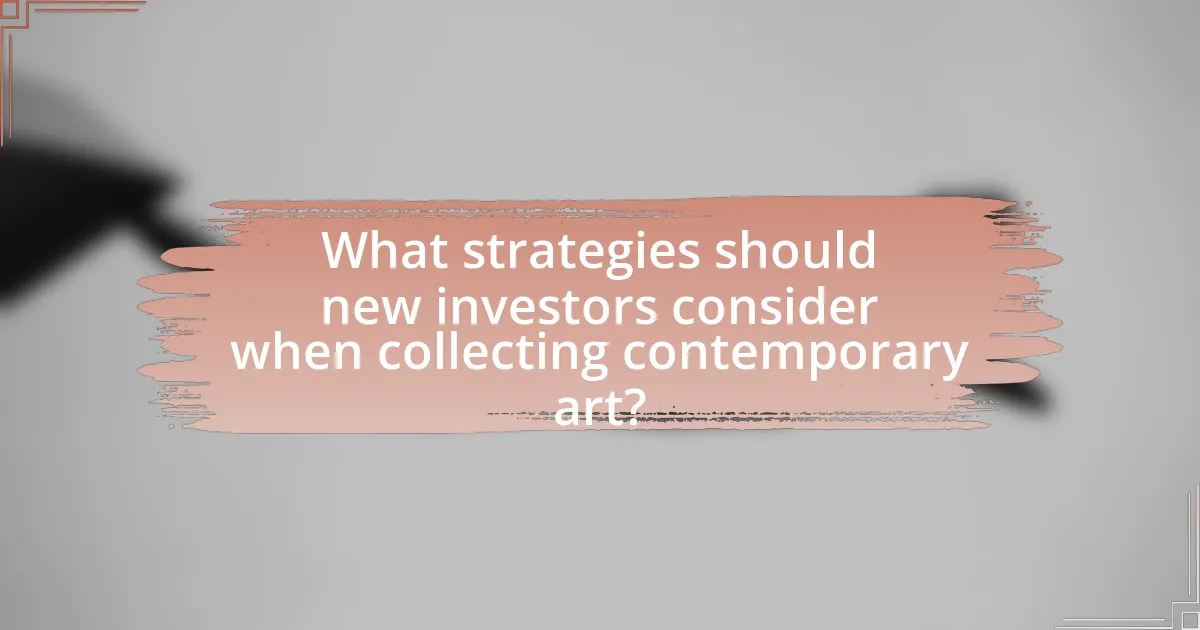
What strategies should new investors consider when collecting contemporary art?
New investors should consider focusing on research, networking, and diversification when collecting contemporary art. Conducting thorough research on artists, market trends, and art history helps investors make informed decisions. Networking with galleries, artists, and other collectors can provide valuable insights and access to exclusive works. Diversifying their collection by investing in various artists and styles mitigates risk and enhances potential returns. According to a report by Art Basel and UBS, the contemporary art market has shown resilience, with a 7% increase in sales in 2021, indicating the potential for growth in this sector.
How can new investors identify valuable contemporary artists?
New investors can identify valuable contemporary artists by researching their exhibition history, critical reception, and market performance. An artist with a strong exhibition history in reputable galleries and museums often indicates recognition and potential value. Additionally, positive reviews from art critics and publications can signal an artist’s significance in the contemporary art scene. Market performance, such as auction results and sales data, provides concrete evidence of an artist’s financial value and demand. For instance, artists like Yayoi Kusama and Banksy have seen substantial increases in their market value due to their established reputations and consistent demand in the art market.
What criteria should be used to evaluate an artist’s potential?
To evaluate an artist’s potential, key criteria include originality, technical skill, market demand, and critical recognition. Originality refers to the uniqueness of the artist’s vision and style, which can set them apart in a crowded market. Technical skill assesses the artist’s proficiency in their chosen medium, influencing the quality and impact of their work. Market demand indicates the artist’s ability to attract collectors and galleries, often reflected in sales history and exhibition frequency. Critical recognition encompasses reviews, awards, and inclusion in prestigious exhibitions, serving as indicators of the artist’s standing within the art community. These criteria collectively provide a comprehensive framework for assessing an artist’s potential in the contemporary art market.
How can emerging artists be discovered in the contemporary art scene?
Emerging artists can be discovered in the contemporary art scene through various platforms and initiatives that promote visibility and accessibility. Art fairs, such as Frieze and Art Basel, often feature sections dedicated to emerging talent, allowing collectors and curators to encounter new artists. Additionally, online platforms like Artsy and Saatchi Art provide digital galleries where emerging artists can showcase their work to a global audience. Furthermore, social media channels, particularly Instagram, have become vital for artists to build their brand and connect directly with potential collectors. Research indicates that 70% of art collectors use social media to discover new artists, highlighting its effectiveness in artist visibility.
What are the best practices for building a contemporary art collection?
The best practices for building a contemporary art collection include researching artists and their work, establishing a budget, and acquiring pieces that resonate personally. Researching artists involves understanding their backgrounds, influences, and market trends, which can be done through gallery visits, art fairs, and online platforms. Establishing a budget is crucial, as it helps collectors make informed decisions without overspending; according to a 2021 Art Basel report, 70% of collectors set a budget before purchasing. Lastly, acquiring pieces that resonate personally ensures that the collection reflects the collector’s taste and values, which can enhance the enjoyment and significance of the collection over time.
How should investors determine their budget for art purchases?
Investors should determine their budget for art purchases by assessing their financial situation, investment goals, and the art market’s dynamics. A clear understanding of personal finances, including disposable income and existing investments, allows investors to allocate a specific amount for art without jeopardizing their overall financial health. Additionally, setting investment goals—whether for appreciation, enjoyment, or diversification—guides the budget-setting process. The art market’s historical performance, such as the 2021 Art Basel report indicating a 29% increase in global art sales, further informs investors about potential returns and helps in making informed budget decisions.
What types of contemporary art should new investors consider collecting?
New investors should consider collecting digital art, street art, and emerging artists’ works. Digital art has gained significant traction, with sales reaching $2.6 billion in 2021, showcasing its growing market presence. Street art, often created by renowned artists like Banksy, has seen pieces sell for millions, indicating strong investment potential. Additionally, works by emerging artists can appreciate rapidly, as seen in the case of artists like Amoako Boafo, whose prices have surged due to increased demand and recognition. Collecting these types of contemporary art can provide both aesthetic enjoyment and financial returns.
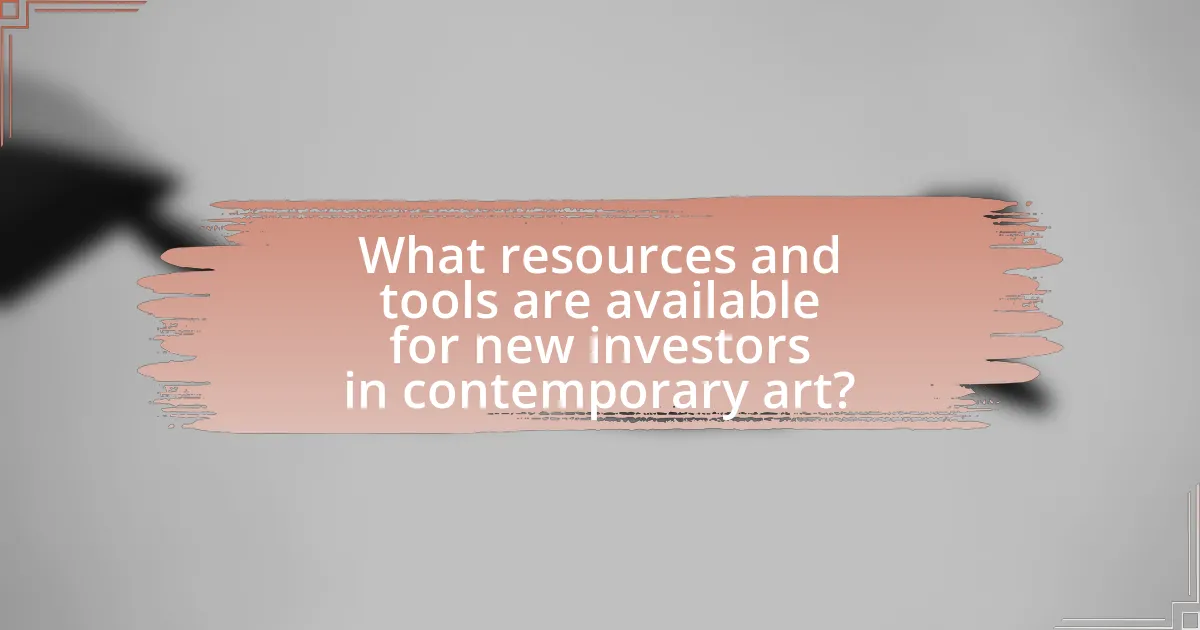
What resources and tools are available for new investors in contemporary art?
New investors in contemporary art can utilize various resources and tools, including online platforms, art fairs, galleries, and educational courses. Online platforms like Artsy and Saatchi Art provide access to a wide range of artworks and artist information, facilitating informed purchasing decisions. Art fairs such as Art Basel and Frieze offer opportunities to view and acquire works from multiple galleries in one location, enhancing exposure to contemporary trends. Additionally, established galleries often host exhibitions and provide expert insights into the market. Educational courses from institutions like Sotheby’s Institute of Art and online platforms like Coursera offer knowledge on art valuation, market trends, and collecting strategies, equipping investors with essential skills for navigating the contemporary art landscape.
How can online platforms assist in the art collecting process?
Online platforms assist in the art collecting process by providing access to a wide range of artworks, enabling collectors to discover, evaluate, and purchase art from various artists and galleries globally. These platforms often feature advanced search tools, allowing users to filter artworks by style, price, and medium, which simplifies the selection process. Additionally, many online art marketplaces offer detailed information about each piece, including artist backgrounds, provenance, and market trends, which helps collectors make informed decisions. For instance, platforms like Artsy and Saatchi Art provide insights into pricing history and artist popularity, enhancing the collector’s ability to assess value and investment potential.
What are the benefits of using art marketplaces and galleries?
Art marketplaces and galleries provide several benefits for collectors, including access to a diverse range of artworks, professional curation, and enhanced visibility for artists. These platforms enable collectors to discover unique pieces from various artists, often featuring both emerging and established talents, which broadens their investment options. Additionally, galleries typically offer expert guidance and curation, helping collectors make informed decisions based on market trends and artistic value. Furthermore, art marketplaces and galleries enhance the visibility of artists, facilitating connections with potential buyers and increasing the likelihood of sales, which can lead to a more vibrant art community.
How can social media influence art investment decisions?
Social media can significantly influence art investment decisions by shaping public perception and trends within the art market. Platforms like Instagram and Twitter allow artists to showcase their work directly to potential buyers, creating a sense of accessibility and immediacy that traditional galleries may lack. For instance, a study by Hiscox in 2021 found that 63% of art buyers use social media to discover new artists, indicating that online visibility can directly impact an artist’s market value. Additionally, social media facilitates community engagement and discussions around art, which can drive demand and influence investment choices. This dynamic interaction often leads to increased visibility for emerging artists, thereby affecting their perceived value and the decisions of investors looking to capitalize on trends.
What role do art fairs and exhibitions play in collecting contemporary art?
Art fairs and exhibitions serve as critical platforms for collecting contemporary art by providing access to a diverse range of artworks and artists in a concentrated setting. These events facilitate direct interaction between collectors, galleries, and artists, enabling collectors to discover new talent and trends in the art market. For instance, major art fairs like Art Basel and Frieze attract thousands of visitors and feature numerous galleries, showcasing works from emerging and established artists alike. This exposure allows collectors to make informed purchasing decisions based on firsthand experience and immediate access to artworks. Additionally, art fairs often include curated exhibitions and talks, enhancing the educational aspect of collecting and helping investors understand the value and context of contemporary art.
How can attending art fairs enhance an investor’s knowledge and network?
Attending art fairs enhances an investor’s knowledge and network by providing direct access to a diverse range of artists, galleries, and industry professionals. These events facilitate face-to-face interactions, allowing investors to engage in discussions about current trends, pricing, and the artistic value of works, which deepens their understanding of the market. Furthermore, art fairs often feature panel discussions and talks led by experts, offering insights into collecting strategies and investment opportunities. This environment fosters networking, as investors can connect with other collectors, curators, and art advisors, expanding their professional relationships and potential collaboration opportunities. The concentration of art market players at these fairs creates a unique platform for learning and relationship-building that is difficult to replicate elsewhere.
What should investors look for when visiting exhibitions?
Investors should look for emerging artists and innovative works when visiting exhibitions. Identifying artists who are gaining recognition can lead to valuable acquisitions, as their works may appreciate in value over time. Additionally, investors should assess the quality and uniqueness of the artworks, as pieces that stand out often have a higher potential for future demand. Engaging with gallery representatives and artists can provide insights into market trends and the artists’ backgrounds, further informing investment decisions. According to a report by Art Basel and UBS, the contemporary art market has shown consistent growth, indicating that strategic investments in exhibitions can yield significant returns.
What are the common pitfalls new investors should avoid?
New investors in contemporary art should avoid overpaying for pieces, neglecting research, and following trends without personal preference. Overpaying can occur when investors lack knowledge of market values, leading to inflated prices; for instance, a lack of understanding of an artist’s previous sales can result in significant financial loss. Neglecting research means failing to understand the artist’s background, the artwork’s provenance, and market demand, which can lead to uninformed purchasing decisions. Additionally, following trends without personal preference can result in acquiring art that does not resonate personally, potentially leading to regret and decreased value over time.
How can emotional decision-making impact art investments?
Emotional decision-making can significantly impact art investments by leading investors to prioritize personal feelings over objective market analysis. This tendency can result in overpaying for artworks due to emotional attachment or the desire to own a piece that resonates personally, rather than considering its market value or potential for appreciation. For instance, a study by the European Journal of Marketing found that emotional factors can influence purchasing decisions, often leading to irrational financial choices in art markets. Consequently, investors may miss opportunities for more lucrative investments or face losses when emotional biases cloud their judgment.
What are the risks associated with speculative art buying?
Speculative art buying carries several risks, including market volatility, lack of liquidity, and authenticity concerns. Market volatility can lead to significant fluctuations in art prices, making it difficult for investors to predict returns. According to a report by Artprice, the contemporary art market experienced a 30% decline during the 2008 financial crisis, illustrating how external economic factors can impact art values. Lack of liquidity poses a challenge as selling art can take time and may not yield the expected price, especially if the market is saturated. Additionally, authenticity concerns arise from the prevalence of forgeries and misattributed works, which can result in financial loss if an investor purchases a piece that is later deemed inauthentic. These factors collectively highlight the inherent risks involved in speculative art investments.
What practical tips can help new investors succeed in collecting contemporary art?
New investors can succeed in collecting contemporary art by focusing on research, networking, and understanding market trends. Conducting thorough research on artists, their backgrounds, and their market value is essential; for instance, platforms like Artsy and Artnet provide valuable insights into artist performance and auction results. Networking with galleries, attending art fairs, and joining art communities can help investors gain access to exclusive works and expert opinions. Additionally, staying informed about current trends, such as the rise of digital art and NFTs, allows investors to make informed decisions. According to a report by Art Basel and UBS, the contemporary art market reached $2.7 billion in sales in 2021, highlighting the potential for growth and investment in this sector.
